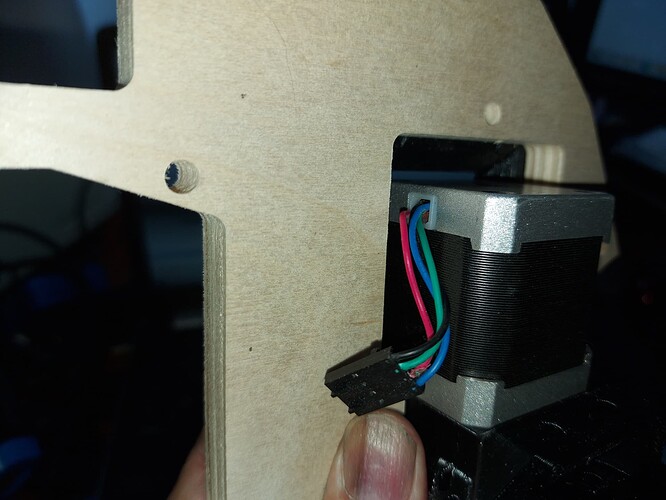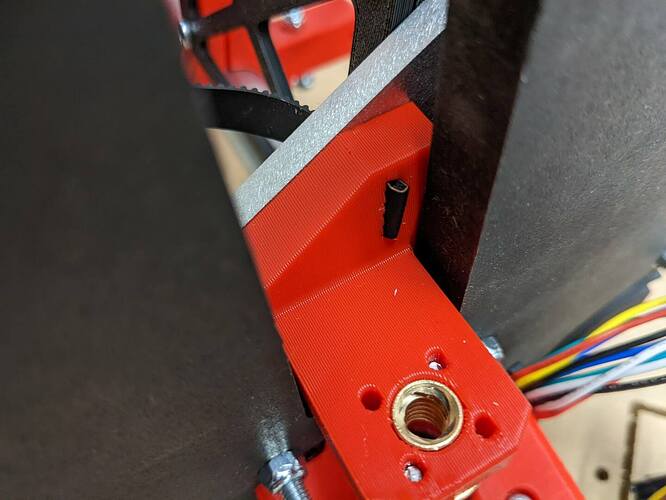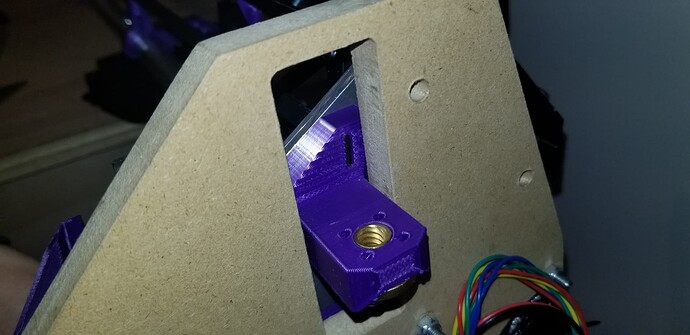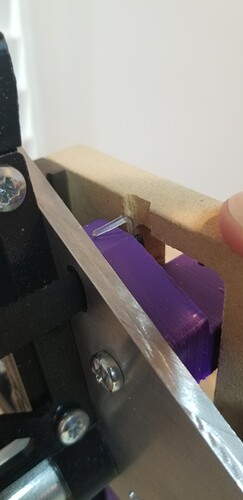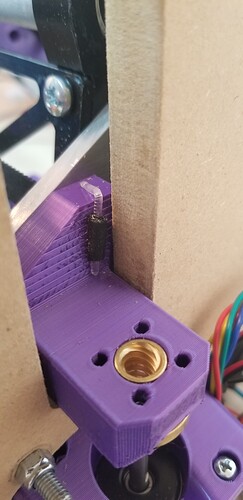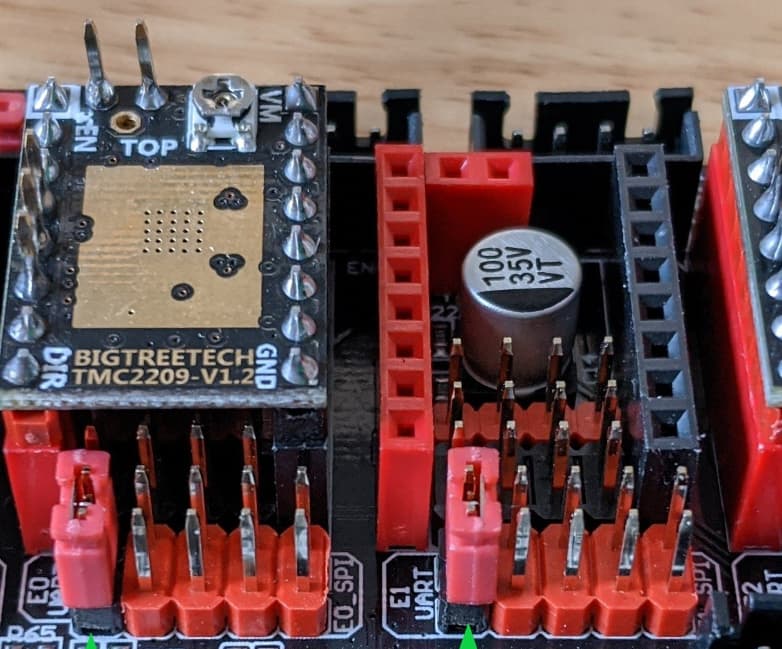He means here. This is a wired stepper, so the wire outlet is small, but the ones with a plug have a 6 pin JST connector there which is difficult to get to. For the motors that V1 sells, and others of this style, it is obviously a non-issue, and it is desirable to have the wire come out the side like this.
I must have the same motors as you and have also rotated 90 degrees to get access to cable connection
My X axis belt keeps failing, it slips through the xz-leadscrew-stub-right slot. My slot hole is too wide/loose. Anyone encountered this?
Cause could be me over tensioning (guessing 10lbs, not sure what note that should sound like?), and/or my printer calibration, or something else? Either way, everything else has been a nice tight fit. I have been lightly reaming holes before screwing, I reverse drill when reaming to avoid boring too much material, but make screwing easier.
Planning to insert paperclip/pin/bolt to prevent belt pulling thru. This may require me gouging top of the YZ plate so Z movement isn’t interfered with.
Personally, I really like the loop back design on the left xz tensioner stub. Maybe similar approach on the right stub would be more resilient, or, maybe inserting M3 thru the top of stub for belt to wrap around back out the side? I know very little about this project, would appreciate recommendations. Cheers!
Related doc image:
10 is too tight, shooting for 5-7.
At this point it is probably stretched out a bit. I would add a shim or just stick a small piece of filament in the middle of it.
There really was not enough room on the plates for the loop back, maybe I cna come up with something else for the stubs if this pops up more.
Oh, you printed them laying down, if you print them sticking up it might give you a different result. You did it the stronger way but it does mess with that slot. Surprised that was not a complete mess of overhangs there.
The red LR3 pic is from the docs. Here’s my Purple LR3, printed with 0.6mm nozzle, 0.32mm layer height.
Cheers for the suggestion. Will workaround/quickfix.
Sweet. I thought that was crazy how similar it was.
For those pictures I had no more matching red and I had to actually carve out the overhangs when I printed them wrong, that is how I knew it wouldn’t work well, 
I actually had the opposite: my slot was too narrow, and I could barely squeeze the single belt through it, no way a doubled-up belt would come back through on mine. I may have had some over-extrusion happening.
Inserted and bent some PETG, slightly notched YZ. If needed, will glue or something that doesn’t compromise the belt.
It has a notch in it, it should not come all the way through doubled up. Sounds like yours printed right, you can ditch the filament I bet.
Mine never needed any filament or other pin of any kind.
Have you made a 3’ one yet? Mine is 3 feet. I tried adjusting the 4’ provided in the v1 LR3 page but it comes out wonky and all the stuff Ryan did I cannot decipher as I am still a fairly new beginner to Fusion. Mainly vases and small stuff for 3D Printing. Still learning. Hoping my certification course comes through soon for acceptance so I can get on the same level as you all!
Looks like @jamiek included a LR3-strut-plate-variable_900x6.svg that’s pretty close to 3’, see Printables , think the set of struts he uploaded are generated using his OpenScad based script that can be used to make any strut length you’d like.
Also, @tgm022861 made parametric Fusion version at Fusion 360 Parametric Model for Strut
Both options look cool, haven’t tried out either yet, still wiring…
I found the files on printables. I adjust from 900 to 914 and it worked great. It was an svg which i can work with that. Was able to adjust and make. Painting them now. Thanks for the help!
Mine didnt need either. When i took it apart, homy crap its snig in there good! Shouldnt need that!
Anyone using tachometer and/or speed controller on their LR3?
Still catching up on related threads/posts. But I see a sensor for sale, but no kit, Optical Sensor - RPM / PID Parts - – V1 Engineering Inc
Would like to run my LR3 at known/expected rpm. Software control would be nice too.
It was more useful for the 660 but the makita and 611 have a built in speed control that works very well. it is really easy to get it dialed in by ear when it holds it’s RPM. The 660 changes RPM with load more.
How did the mailing go?
For LR3, digging thru the forum, feels like Makita > 611 > 660. Difference between Makita and 611 not being much.
Was deciding on spindle, part of that involved thinking ahead to probable future mods… Wanted to understand whether the Makita, or the 611 will be easier to modify with tachometer and/or speed control using SuperPID or similar, or some cheaper V1E or custom triac/POT solution even. Operating at known speed, and sending a single job with multiple paths with different speeds would be nice to have in the future. Am coming from Genmitsu 3040 which lets you set and vary speed through out a cut, but no tachometer, so who knows what actual speed is, especially as load varies.
Found @iamthesoundman’s Makita mod to integrate SuperPID Building A CNC Machine | Part 4 | Super PID Wiring & setup with Makita RT0701C | MPCNC Motor Control - YouTube, very helpful, cheers for that!
Sticking with my Makita! Unless someone convinces me otherwise, please let me know soon though, am spraying my Makita to color match my core, as soon as I can track down high temp rainbow spray paint.
If you want speed control, get a spindle with a VFD. That will be better and safer than modifying a router. In the end the price will be similar.
LR3 / SKR docs suggest bending the driver’s Diag pin. Anyone else notice the bent pins could end up touching top of the Capacitor below the driver? No idea if that’d cause an issue (?), and didn’t want to find out, so I’ve been clipping off the Diag pin instead of bending. Clipped pins using cutters I usually use on 3D filament. Pins fly off at high speed, usually straight into your good eye. Don’t rely on safety squints, I recommend eye protection and cover/shield with your free hand during the cut so the shrapnel falls close by.
